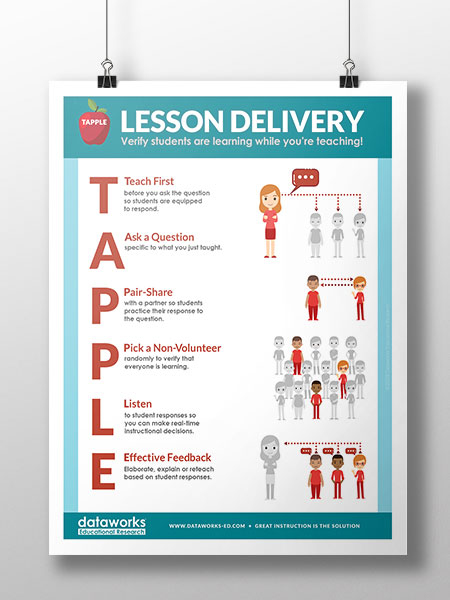Professional Development With Explicit Direct Instruction (EDI)®
Help teachers deliver effective lessons that can significantly improve achievement for all learners, including English language learners and students with special needs.

Learn More About EDI
Enter your school email address, and we will get back to you.
Explicit Direct Instruction (EDI)® 5 Day Training Plan
Day 1 - Explicit Direct Instruction (EDI)®
On the first day, participants are introduced to the core principles and objectives of Explicit Direct Instruction (EDI)® , a proven teaching model aimed at achieving 80-100% student success in every lesson. The session begins with an overview of the research supporting EDI and includes a reflective activity where teachers consider how these findings can be applied in their classrooms.
The training dives into the science of how students process and retain information, emphasizing instructional design strategies that maximize retention. Teachers reflect on how brain research can inform and improve their instructional practices.
An engaging segment on student engagement highlights methods for maintaining active participation every 97 seconds through listening, speaking, reading, and writing. Participants watch classroom practice videos, practice these strategies with partners, and reflect on how to implement them effectively in their teaching.
Teachers are guided through the components of an EDI lesson, including defining clear learning objectives, activating prior knowledge, concept and skill development, guided practice, relevance, and closure. They analyze sample EDI lessons with grade-level peers using online resources to connect theory to practice.
The day also focuses on techniques for checking student understanding in real time. Teachers learn to use the TAPPLE® framework: teach first, ask a specific question, pair-share, pick a random student, listen to their response, and provide effective feedback. This includes strategies for asking higher-order questions, using whiteboards for immediate feedback, and reteaching when student success is below 80%.
The session concludes with an exploration of effective feedback and coaching, emphasizing real-time application of teaching strategies. Teachers reflect on how to incorporate peer coaching into their professional growth and practice key strategies to ensure 100% correct student responses. By the end of the day, educators are equipped with actionable tools to enhance lesson success and student engagement.
Days 2, 3, and 4 - Lesson Demonstrations and Teacher Practice
During Days 2-4, the training focuses on practical application through demonstration lessons and teacher-led practice. Teachers work in grade-level or content-area cohorts (e.g., K-1, 2-3, 4-6, and subject-specific groups for middle and high school). Lessons are selected collaboratively by schools and DataWORKS consultants from the extensive catalog available on educeri.com.
Each day follows a structured schedule, including one or two demonstration lessons based on the number of participants. Roving substitute teachers release cohorts to observe and participate in the training. The process begins with a pre-brief session, where the lesson plan is reviewed and discussed in detail to prepare teachers for observation.
The DataWORKS consultant delivers the lesson directly to students, providing a live demonstration while teachers observe. This is followed by a debrief session where the consultant and teachers analyze the lesson, focusing on key strategies and techniques.
Next, teachers take an active role by teaching the same lesson to different students. Typically, three teachers divide the lesson into segments, with each teaching a specific part. This allows participants to practice their delivery and refine their instructional techniques. Throughout this process, DataWORKS consultants provide in-situ coaching, offering real-time feedback and support to ensure the implementation of effective teaching practices.
The day concludes with a final debrief session, where participants reflect on the day’s experiences, identifying key takeaways and strategies they can incorporate into their daily classroom routines. The hands-on nature of Days 2-4 ensures that teachers leave the training equipped with practical skills and confidence to implement EDI strategies effectively.
Day 5 - Instructional Leadership and Classroom Observations
Day 5 focuses on equipping administrators, academic coaches, and school leaders with the tools to observe and quantify the implementation of EDI practices, ensuring sustainable improvement. This session provides a framework for effective classroom observations and strategic planning.
The day begins with a pre-brief session where participants review the observation process, including how to use specific forms for recording data. Emphasis is placed on identifying key instructional practices, such as EDI lesson components, student engagement strategies, and methods for checking understanding.
Observers conduct two rounds of classroom visits, observing 10 random classrooms for five minutes each. During these short visits, they record observed practices and note evidence of EDI strategies in action. After each observation, participants gather in the hallway to discuss the practices they witnessed and share insights.
Following the classroom visits, the group engages in a structured debrief to analyze the collected data. This includes identifying patterns, areas of success, and opportunities for improvement. Participants work collaboratively to draft SMART goals based on their observations, focusing on actionable, measurable outcomes that will drive instructional growth.
The session concludes with strategic planning for future implementation. This includes setting timelines for follow-up observations, identifying professional development needs, and creating a roadmap for sustained use of EDI practices. By the end of the day, school leaders have a clear plan to support and monitor the ongoing integration of EDI strategies in their classrooms.




Before Explicit Direct Instruction (EDI), our school was a ship adrift at sea with everyone rowing in different directions. EDI has provided us with a framework for instruction and a common language that allowed us to all row in the same direction. By doing so, we exited program improvement within the first two years of implementation, after having been in sanctions for the previous ten years. Additionally, using the framework and common language of EDI we were named a honor roll school by the Educational Results Partnership

Learn Explicit Direct Instruction (EDI)® From The Founders
Dr. Silvia Ybarra, PhD and John Hollingsworth are founders and co-creators of Explicit Direct Instruction (EDI)®.
EDI® focuses on improving education at the lesson level by incorporating a strategic collection of instructional practices from the work of educational and cognitive researchers such as Hattie, Rosenshine, Hunter, Sousa, and Marzano. When all of the research is combined, you get EDI®.
The extensive classroom experience of the Dataworks founders and staff has proven that direct instruction is more effective and efficient, especially for struggling students and English learners.
In fact, there is overwhelming research supporting teacher-led, explicit, direct instruction. Dataworks built upon this approach, developing and refining our own specific version of direct instruction, called Explicit Direct Instruction (EDI)®.
Does EDI® Work for High-Stake Testing?
With Assessments using Common Core State Standards, the Dataworks’ EDI® approach to teaching has become more relevant than ever before. The EDI® collection of research-based strategies includes 75% of the shifts to Common Core, such as text-based lessons, text-based answers, academic and content vocabulary, strong concepts as well as skills, and real-world connections. Recall questions are great, however, teachers need to get application-based questions for their students to be successful in the era of High-stakes testing.
In addition, EDI® Lessons and Lesson Design training have evolved to include more Informational (expository) text, more application problems, Common Core learning objectives, and Access to Common Core questions that utilize the new types of assessments. With our training in the pedagogy of EDI, High-Stake testing questions will be more doable for your students.


About Dataworks Methodology
Instruction should be a dialog that’s interactive and engaging; so students are given the opportunity to demonstrate what they are learning and teachers make instructional decisions based on the students’ responses.
We are not waiting for test results, but instead, making academic corrections to ensure the success of the lesson and ultimately releasing the students to independent practices.
How EDI® EDI Can Improve Math Instruction
In mathematics, EDI is especially effective because it breaks down complex concepts into clear, easy-to-understand steps, ensuring that all students can follow the progression from basic to advanced skills. Here’s how EDI applies to math instruction:
Structured Problem-Solving: EDI helps students approach math problems in a structured way by guiding them through each step of the problem-solving process. Teachers model each step, making sure that students understand the reasoning behind each operation.
Incremental Learning: Mathematical concepts often build on each other, and EDI ensures that teachers introduce these concepts gradually, allowing students to master one concept before moving on to the next.
Formative Assessments for Math: Teachers frequently check for understanding during lessons to ensure that all students are following along. In math, this can involve quick quizzes, asking students to solve problems on whiteboards, or using clicker technology for immediate feedback.
Addressing Math Misconceptions: Misconceptions are common in math, and EDI’s focus on checking for understanding allows teachers to identify and address these misconceptions in real-time, preventing them from becoming barriers to further learning.

EDI has been a huge part of our success. We took Datawork’s ideas and training and took ownership of them and continued to build teacher competence. EDI provided a common language for instruction and very clear steps for students to learn. EDI is our instructional method, but also the base of our PLCs and RTIs.
Educator Feedback About EDI®
Learn about the positive impact EDI® has for administrators, teachers, and students.
Our EDI implementation is going really well. Lots of our staff were so impressed with your workshop and demonstrations in the school that they had renewed energy around EDI implementation.
EDI is very concrete. You can walk into a class and recognize it right away. It enables us to give much better feedback to teachers.
Even with all my training and experience, I still learned something new daily.
EDI was the impetus for all of the progress at Sanger Unified.
The EDI® Training Includes:
- How to get 100% correct answers from all students.
- Effective lesson design and effective delivery.
- Learn ways to motivate all students.
- Get students to complete their homework.
- Brain compatible teaching that helps students learn more.
- 8 ways to create student engagement.
- Choral reading to improve student reading fluency.
- Corrective feedback strategies.
- Expand student academic vocabulary in every lesson.
- Steps for Checking for Understanding.
- Improve classroom management.
- Higher-order questions that help students learn more.
- Student whiteboards to increase student learning.
- The proper use of sentence frames in questioning.
- Supercharging concept development in every lesson.
Ready To Meet Our Education Experts?
Use the button below to book a meeting on our calendar
Create The Foundation for Teaching Excellence

What Does Explicit Direct Instruction (EDI)® Training Cover?
Our trainers will provide coaching and feedback for the strategies covered in the workshop and participants will be asked to practice in small groups. This leads to increased teacher retention for the following:

Brain Research
Dataworks provides an overview of brain research. We explain how the human brain learns and stores information. This helps teachers understand the importance of the lesson delivery strategies in Explicit Direct Instruction EDI® .

Engagement Norms
Practice with Student Engagement Norms. Dataworks Engagement Norms are used in thousands of classrooms around the world because they work. They include eight strategies that keep students engaged and actively participating in every lesson.

Checking for Understanding
Most teachers know how to ask questions and call on students for responses. But are teachers asking the right questions to the right students? EDI® has simple tips to help teachers ask powerful, probing questions to non-volunteers that will change the culture of the classroom and accurately assess learning in real-time.

Lesson Design Components
Create a culture of instructional excellence by providing common procedures for lessons. We cover the critical components of the Explicit Direct Instruction (EDI)® lesson design; learning objective, activate prior knowledge, concept development, sill development with guided practice, relevance, and closure.

How Does EDI® Help Students?
Explicit direct instruction (EDI) is a teaching method that benefits students by providing clear learning objectives, breaking down complex concepts, and giving step-by-step guidance.
It engages students actively, offers direct teaching, and offers immediate feedback.
EDI builds skills, addresses learning gaps, boosts confidence, and teaches transferable skills. It’s efficient, focused, and helps students succeed across subjects.
Is EDI® Training Necessary?
EDI can be particularly beneficial for students who need clear structure, guidance, and practice in mastering foundational skills. It’s effective for addressing learning gaps, building confidence, and improving student outcomes.


When To Deploy EDI® Training
It’s effective, evidence-based, and can be useful for new teachers, initial instruction, school reform, and maintaining accountability.
EDI keeps students engaged throughout the lesson! It gives students the opportunity to speak and listen to each other during the lesson. Students discuss vocabulary and read aloud during EDI which gives them practice in Reading, Speaking, Listening, and Writing. Students do all the work during a lesson! Pair-Share is a great strategy to help English Learners with speaking and practicing the vocabulary!
Explicit Direct Instruction (EDI)® Videos
YouTube Channel: https://www.youtube.com/@dataworksed
EDI® Resources and Related Articles
Differentiation And Scaffolding With Explicit Direct Instruction®



